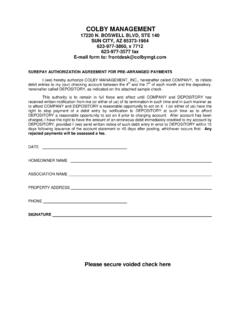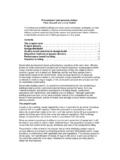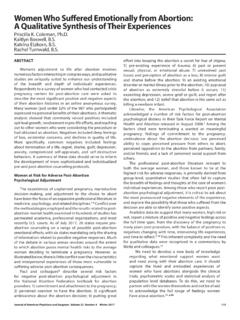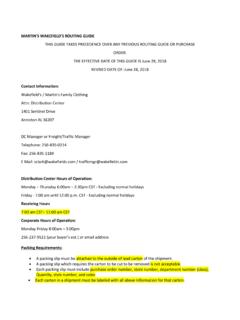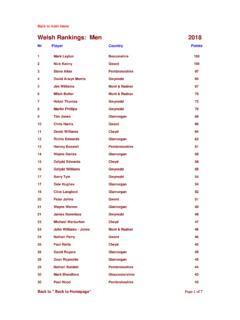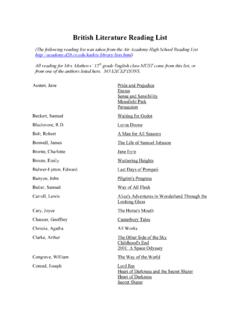Transcription of PICOT, Problem Statement, Research Question, …
1 Associative hypothesis Categorical variable Causal hypothesis Complex hypothesis Confounding variable Continuous variableChapter ObjectivesAt the conclusion of this chapter, the learner will be able to1. Discuss processes involved in identifying a researchable Problem in nursing practice2. Write an effective Problem statement3. Discuss essential characteristics needed to pose a Research question4. Identify the criteria for establishing Research variables5. Contrast the various types of hypotheses6. Explain the differences between conceptual and operational definitions7. Critically evaluate Research questions and hypotheses found in Research reports for their contribution to the strength of evidence for nursing practiceKey TermsChapterPICOT, Problem Statement, Research question , HypothesisLucy B. Trice and Kathaleen C. Bloom52ND PAGES Jones & Bartlett Learning, LLC. NOT FOR SALE OR DISTRIBUTION.
2 Jones & Bartlett Learning, LLCNOT FOR SALE OR DISTRIBUTION Jones & Bartlett Learning, LLCNOT FOR SALE OR DISTRIBUTION Jones & Bartlett Learning, LLCNOT FOR SALE OR DISTRIBUTION Jones & Bartlett Learning, LLCNOT FOR SALE OR DISTRIBUTION Jones & Bartlett Learning, LLCNOT FOR SALE OR DISTRIBUTION Jones & Bartlett Learning, LLCNOT FOR SALE OR DISTRIBUTION Jones & Bartlett Learning, LLCNOT FOR SALE OR DISTRIBUTION Jones & Bartlett Learning, LLCNOT FOR SALE OR DISTRIBUTION Jones & Bartlett Learning, LLCNOT FOR SALE OR DISTRIBUTION Jones & Bartlett Learning, LLCNOT FOR SALE OR DISTRIBUTION Jones & Bartlett Learning, LLCNOT FOR SALE OR DISTRIBUTION Jones & Bartlett Learning, LLCNOT FOR SALE OR DISTRIBUTION Jones & Bartlett Learning, LLCNOT FOR SALE OR DISTRIBUTION Jones & Bartlett Learning, LLCNOT FOR SALE OR DISTRIBUTION Jones & Bartlett Learning, LLCNOT FOR SALE OR DISTRIBUTION Jones & Bartlett Learning, LLCNOT FOR SALE OR DISTRIBUTION Jones & Bartlett Learning, LLCNOT FOR SALE OR DISTRIBUTION Jones & Bartlett Learning, LLCNOT FOR SALE OR DISTRIBUTION Jones & Bartlett Learning, LLCNOT FOR SALE OR DISTRIBUTION Jones & Bartlett Learning, LLCNOT FOR SALE OR DISTRIBUTIONI ntroductionEvery Research study begins with a Problem the researcher would like to solve.
3 For such a Problem to be researchable, it must be one that can be studied through collecting and analyzing data. Some problems, although interesting, are by their nature not appropriate Research problems because they are not researchable. Problems involving moral or ethical issues are not researchable, as the solutions to these prob-lems are based on an individual s values. For example, one could not Research a question such as Should marijuana use be legalized? because the answer to the question depends on one s values rather than on a clearly right or wrong answer. This is not to say that mari-juana use cannot be studied. One could study people s opinions regarding marijuana use. For example, one might ask the question , Do cancer patients hold more favorable opinions regarding legaliza-tion of marijuana use than the general public? The need to avoid moral/ethical questions as a Research topic applies to both quantitative and qualitative factors influence whether a Problem is researchable using quantitative methods.
4 For a Problem to be considered researchable by quantitative methods, the variables to be studied must be clearly defined and measurable. This clarity is necessary to apply statistical measures that will identify relationships among the variables. Qualita-tive studies are not subject to the same restriction, as the purpose of these studies is to describe in detail the phenomenon of interest as it is perceived by the study subjects. In other words, qualitative studies are descriptive in nature and are not concerned with relationships among variables. Demographic variable Dependent variable Dichotomous variable Directional hypothesis Discrete variable Extraneous variable Hypothesis Independent variable Nondirectional hypothesis Null hypothesis Problem statement Research hypothesis Research question Simple hypothesis Variable122 | Chapter 5 PICOT, Problem Statement, Research question , Hypothesis 2ND PAGES2ND PAGES Jones & Bartlett Learning, LLC.
5 NOT FOR SALE OR DISTRIBUTION. Jones & Bartlett Learning, LLCNOT FOR SALE OR DISTRIBUTION Jones & Bartlett Learning, LLCNOT FOR SALE OR DISTRIBUTION Jones & Bartlett Learning, LLCNOT FOR SALE OR DISTRIBUTION Jones & Bartlett Learning, LLCNOT FOR SALE OR DISTRIBUTION Jones & Bartlett Learning, LLCNOT FOR SALE OR DISTRIBUTION Jones & Bartlett Learning, LLCNOT FOR SALE OR DISTRIBUTION Jones & Bartlett Learning, LLCNOT FOR SALE OR DISTRIBUTION Jones & Bartlett Learning, LLCNOT FOR SALE OR DISTRIBUTION Jones & Bartlett Learning, LLCNOT FOR SALE OR DISTRIBUTION Jones & Bartlett Learning, LLCNOT FOR SALE OR DISTRIBUTION Jones & Bartlett Learning, LLCNOT FOR SALE OR DISTRIBUTION Jones & Bartlett Learning, LLCNOT FOR SALE OR DISTRIBUTION Jones & Bartlett Learning, LLCNOT FOR SALE OR DISTRIBUTION Jones & Bartlett Learning, LLCNOT FOR SALE OR DISTRIBUTION Jones & Bartlett Learning, LLCNOT FOR SALE OR DISTRIBUTION Jones & Bartlett Learning, LLCNOT FOR SALE OR DISTRIBUTION Jones & Bartlett Learning, LLCNOT FOR SALE OR DISTRIBUTION Jones & Bartlett Learning, LLCNOT FOR SALE OR DISTRIBUTION Jones & Bartlett Learning, LLCNOT FOR SALE OR DISTRIBUTION Jones & Bartlett Learning, LLCNOT FOR SALE OR DISTRIBUTIONI dentifying Researchable ProblemsThere are a number of sources from which researchable problems can arise.
6 Personal experience, whether as a healthcare professional or as a consumer of health care, is a rich source. For example, reviewing procedure manuals might raise the question , Does one procedure for giving mouth care apply to all patients? In consider-ing such diverse groups of patients as those with endotracheal or nasogastric tubes in place; those with full-blown AIDS, often accom-panied by buccal mucosal lesions; and cancer patients on chemo-therapy, one might ask, Does one size fit all, or should separate procedures be established for each case? Thus, as many authors point out (Macnee & McCabe, 2008; Norwood, 2010; Polit & Beck, 2010; Schmidt & Brown, 2012), practice experience is a major source for identifying gaps in knowledge that would benefit from nursing literature can also be a valuable source for Research -able problems, particularly for the novice researcher (Burns & Grove, 2007; Norwood, 2010; Polit & Beck, 2010).
7 For example, the researcher might identify a topic of interest and then review the nursing Research literature to determine which kinds of studies have been done in that area. Seeing how other researchers have approached a Problem can often spark new ideas or perhaps point to studies that would benefit from replication. In addition to offer-ing such indirect assistance in the development of a Problem statement, the Research literature, including unpublished disserta-tions and theses as well as published Research articles, provides direct assistance through specific suggestions for future Research in the area. These suggestions may be offered under a special heading for future Research , or they may be part of the discussion of the issues often give rise to topics relevant to healthcare Research (Norwood, 2010; Polit & Beck, 2008, 2010). For example, the feminist movement raised questions about gender equity in health care and in healthcare Research .
8 The civil rights movement led to Research on minority health problems in general and to explorations of the differences in effectiveness of medical treatment in different ethnic in the population including increasing numbers of elderly, and increasing numbers of individuals with one or more chronic diseases, also provide impetus for healthcare Research . For example the emergence of conditions such as Alzheimer s Disease has led to Research dealing with the nursing care of these patients, as well as Research in how best to give care for the caregiver (Elliott, Burgio, & DeCoster, 2010). The rising epidemic of obesity at all ages of the Introduction | 1232ND PAGES2ND PAGES Jones & Bartlett Learning, LLC. NOT FOR SALE OR DISTRIBUTION. Jones & Bartlett Learning, LLCNOT FOR SALE OR DISTRIBUTION Jones & Bartlett Learning, LLCNOT FOR SALE OR DISTRIBUTION Jones & Bartlett Learning, LLCNOT FOR SALE OR DISTRIBUTION Jones & Bartlett Learning, LLCNOT FOR SALE OR DISTRIBUTION Jones & Bartlett Learning, LLCNOT FOR SALE OR DISTRIBUTION Jones & Bartlett Learning, LLCNOT FOR SALE OR DISTRIBUTION Jones & Bartlett Learning, LLCNOT FOR SALE OR DISTRIBUTION Jones & Bartlett Learning, LLCNOT FOR SALE OR DISTRIBUTION Jones & Bartlett Learning, LLCNOT FOR SALE OR DISTRIBUTION Jones & Bartlett Learning, LLCNOT FOR SALE OR DISTRIBUTION Jones & Bartlett Learning, LLCNOT FOR SALE OR DISTRIBUTION Jones & Bartlett Learning, LLCNOT FOR SALE OR DISTRIBUTION Jones & Bartlett Learning, LLCNOT FOR SALE OR DISTRIBUTION Jones & Bartlett Learning, LLCNOT FOR SALE OR DISTRIBUTION Jones & Bartlett Learning.
9 LLCNOT FOR SALE OR DISTRIBUTION Jones & Bartlett Learning, LLCNOT FOR SALE OR DISTRIBUTION Jones & Bartlett Learning, LLCNOT FOR SALE OR DISTRIBUTION Jones & Bartlett Learning, LLCNOT FOR SALE OR DISTRIBUTION Jones & Bartlett Learning, LLCNOT FOR SALE OR DISTRIBUTION Jones & Bartlett Learning, LLCNOT FOR SALE OR DISTRIBUTION population, and especially in childhood, highlights the need for Research into methods to promote skill building with regard to healthy lifestyles (Melnyk, 2008). The Institute of Medicine s report on profes-sional education suggests that these shifts in population and changing face of our society also demand a revamping of professional education to better deal with these issues (Institute of Medicine Board on Health Care Services, 2003).Think Outside the Box?Using the following examples, develop Problem statements, Research questions, and/or hypotheses for each one.
10 (1) Which information has been used to determine the method of catheterizing a laboring mother? (2) Which information serves as the basis for the range of blood sugars used within newly diagnosed elderly diabetics? (3) Which items need to be included into the formation of a Problem statement, Research question , and hypothesis?The Research priorities of the profession, and particularly of the funding bodies interested in healthcare Research , are also a primary source for generating researchable problems (Burns & Grove, 2011; Norwood, 2010). For example, the National Institute of Nursing Research (NINR, ) is the largest federal funding body dedicated specifically to nursing Research . The NINR has as its mission to promote and improve the health of individuals, families, communi-ties, and populations (p. 4). The Institute supports both clinical and basic Research , and also provides funding for researcher training.










